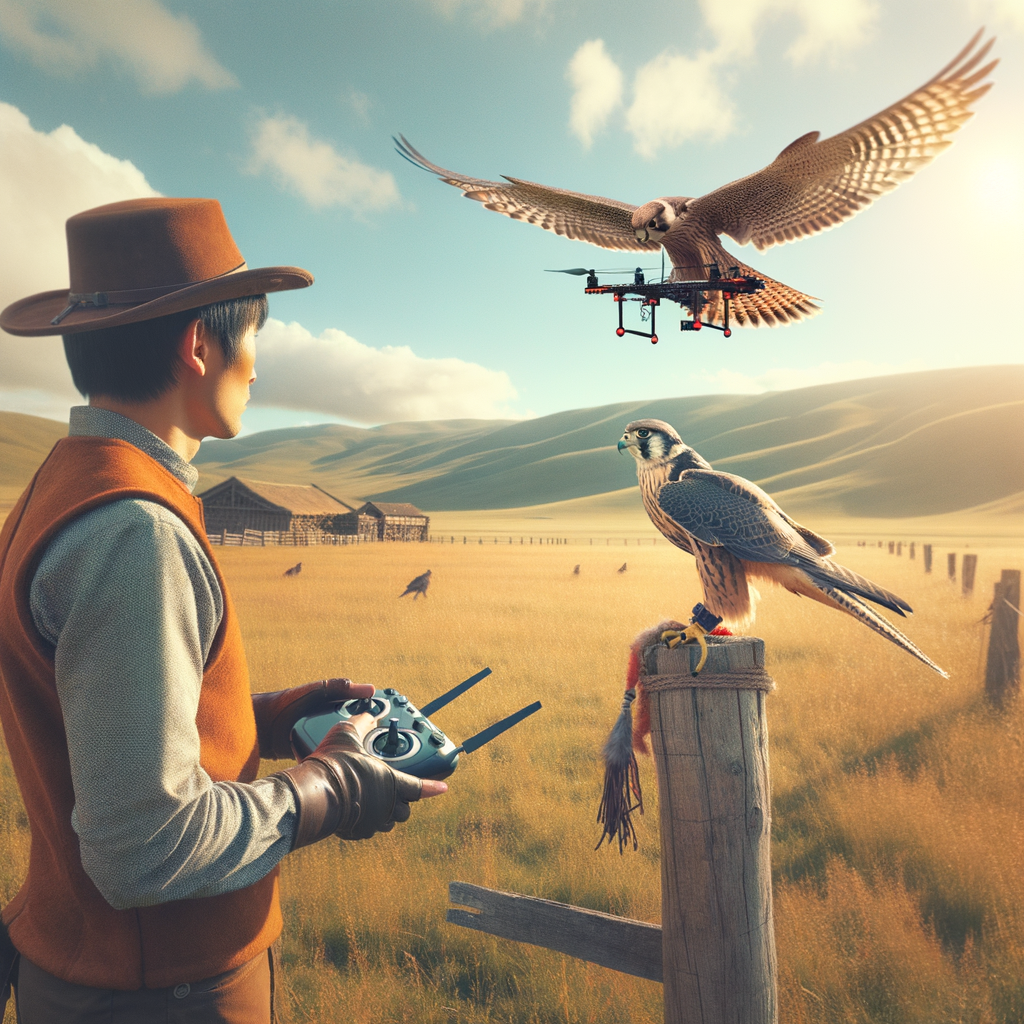Using Drones for Falconry
- Innovative Training: Drones can help train birds by simulating prey movements.
- Safety First: Using drones reduces the risk of injury to birds during training.
- Exercise Advantage: Birds get better exercise as they chase the drone, improving their skills.
- Versatile Technology: Various types of drones are available, from simple to advanced models.
- Remote Control: Trainers can control the drone from a safe distance.
- Weather Conditions: Drones can be used in different weather conditions, providing consistent training opportunities.
- Cost-Effective: Long-term savings due to fewer injuries and better-trained birds.
- Maintenance Required: Drones need regular checks and repairs to ensure they function properly.
- Ethical Considerations: Important to use drones responsibly to ensure the well-being of the birds.
- Increased Success Rates: Birds trained with drones often have higher success rates in hunting and competitions.
Embracing Drones in Falconry: A Modern Twist on an Ancient Art
Today, this ancient practice is taking a fascinating turn with the introduction of drones. Yes, you read that right! Drones are now being used to enhance and support falconry in ways our ancestors could never have dreamed. Welcome to Learn Falconry, where we honor time-tested traditions while embracing cutting-edge technology to make falconry more thrilling and efficient.
But, why should you care about this mix of old and new? Picture this: just like mastering a classic Irish jig can bring joy and agility to dancers young and old, incorporating drones into falconry can create an exhilarating, dynamic experience for both the falcon and its trainer. The drone acts like an extension of the falconer’s arm, helping to train and exercise these magnificent birds with unprecedented precision and reaching new heights’literally and figuratively!
Stay with us as we delve into how drones are revolutionizing falconry and why this innovative approach is creating waves in the world of bird training. You’ll discover how drones replicate the natural flight patterns of prey, keep falcons fit and focused, and offer a myriad of other benefits that make them invaluable to both novice and seasoned falconers alike. Get ready to soar into the future of falconry!
Exploring Falconry Drones: Techniques and Methods
Understanding Falconry Drones
Falconry drones have become an innovative tool in modern falconry, offering unique ways to train and exercise falcons. These drones are equipped with various features that simulate the natural flight of prey, providing an effective training environment for falcons. By integrating technology with traditional practices, falconers can enhance their methods and techniques.
Different Falconry Drone Techniques
When we talk about falconry drone techniques, we’re looking at the methods these drones are used to train and condition falcons. One popular technique is using drones to simulate the flight of a bird, encouraging a falcon to chase and engage. This technique helps the falcon practice its hunting skills in a controlled setting.
Another technique involves attaching bait or lures to the drone, which can be used to teach falcons targeting and capturing prey mid-air. This method not only improves the falcon’s accuracy but also its agility and endurance.
Methods of Using Drones in Falconry
The methods falconers use with drones can vary depending on the needs of the falcon and the specific training goals. In some scenarios, drones serve as moving targets, flying in patterns that mimic the erratic movements of live prey. This method can help transfer the falcon’s natural predatory instincts onto artificial targets, enhancing their hunting proficiency.
Moreover, some falconers incorporate advanced telemetry and GPS technology in drones to monitor the training sessions. These tools provide valuable data on the falcon’s flight patterns, speed, and overall performance, aiding in refining training techniques for better outcomes.
What Drones are Used in Falconry?
Wondering what drones are used in falconry? There are several types specifically designed or adapted for falconry training. These drones usually feature robust construction to withstand the rigors of falcon training sessions. Additionally, they often come with high-performance motors and long battery life to support extended periods of use.
Falconry drones typically include features such as programmable flight paths, high-speed capabilities, and the ability to carry various types of lures or baits. Some popular models used in falconry are equipped with safety mechanisms to prevent injuries to the falcon or damage to the drone itself.
Enhancing Training with Advanced Falconry Techniques
For more advanced falconry training methods, integrating drones can offer significant benefits. High-speed drones can simulate fast-moving prey, challenging the falcon’s abilities and pushing it to new heights of performance. Furthermore, some drones are customized to include audio and visual stimuli, which can mimic the behavior of different species of prey.
To learn more about traditional and modern falconry techniques, you can explore resources like Basic Falconry Techniques and Advanced Falconry Techniques.
Embracing Technology in Falconry Training
Embracing technology in falconry training is an exciting development in the ancient art of falconry. These modern innovations, like falconry drones, offer new ways to engage and challenge falcons, ultimately leading to more effective training and stronger, more capable birds of prey. For more insights into current advancements, visit our page on Falconry Technology.
By combining age-old traditions with cutting-edge technology, falconry continues to evolve, ensuring that this magnificent practice remains relevant and effective in training the next generation of falcons.
Advanced Falconry Drones in 2024
In 2024, falconry drones bring a whole new level of innovation to the ancient art of falconry. These drones help train birds of prey, particularly falcons, by providing various features and benefits that enhance their natural hunting skills. Let’s explore these drones and see how they revolutionize falconry.
Specifications and Features
Below is a comparison table demonstrating some key specifications of popular falconry drones suited for training in 2024:
| Feature | Falcon-SIHA | Falconry Drone | Falcon II LE |
|---|---|---|---|
| Weight | 1.5 kg – 3.5 kg | 1.5 kg – 3.5 kg | 1.5 kg – 3.5 kg |
| Max Flight Speed | 55 km/h | 72 km/h | 72 km/h |
| Max Flight Time | 30 min | 30 min | 60 min |
| Max Payload Capacity | 2 kg | 2 kg | 9 kg |
| Max Altitude | Up to 5000 meters | Up to 5000 meters | Up to 5000 meters |
| Water Resistance | IP67 | IP67 | IP67 |
Training Methods
Falconry training regimens in 2024 involve structured exercises focused on simulating natural predation scenarios. The following training methods help improve a falcon’s predatory abilities:
- Chasing Drones and Targets: This involves mimicking behaviors like high-altitude flights and quick changes of direction.
- Parachute-Lures and Anti-Breakage Devices: These ensure the safety of the falcons during training sessions.
- Use of Mini Aircraft: Devices like the Berghwing are agile and safe substitutes for drones.
Specialized Capabilities
Falconry drones are packed with several features designed to aid falcon training:
- Autonomous and Semi-Autonomous Flight: Drones can operate with minimal human intervention, offering consistent training routines.
- GPS and Altimeter: These features facilitate precise navigation, helping drones mimic real prey movements effectively.
- Obstacle Avoidance: Ensures that drones can operate safely even in complex environments.
- Night Vision: Allows night-time training, which adds an extra layer of challenge for the birds.
- Redundant Systems: Enhance the reliability of drones by providing backup systems.
- Smart Battery Management: Extends flying time and ensures efficient power usage.
Equipment Used and Data Collection
Falconry drones in 2024 not only help in training but also in data collection:
- Radar Data Collection: Using systems developed by the Millimetre Wave Group, trials gather triple-frequency radar data of birds in flight.
- Machine Learning: Classification tools differentiate between the radar signatures of birds and drones, ensuring accurate data analysis.
Safety Features
Various safety features are integrated into these drones to ensure their durability and the safety of the birds:
- Return to Home: Drones automatically return to their starting point if communication is lost.
- Emergency Landing: Ensures safe recovery during unexpected issues.
- Redundant Systems: Provides additional security by ensuring continued operation even in case of a partial failure.
Versatility and Durability
The drones designed for falconry are simple, relatively inexpensive, and highly versatile:
- Advanced Stabilization and GPS: These features allow the drones to maintain steady flight even when a falcon slams into the lure.
- High Altitude Training: Drones carry lures hundreds of feet in the air, helping falcons develop their flight and hunting skills efficiently.
The Future of Falconry: Insights from 2024
Falconry is evolving rapidly with the help of innovative drone technology. These advanced falconry drones are lightweight, agile, and packed with features that make training birds of prey safer and more effective. With speeds up to 72 km/h and flight times reaching up to 60 minutes, they provide ample opportunities for falcons to practice high-altitude flights and quick changes in direction.
Equipped with GPS, altimeters, obstacle avoidance systems, and even night vision, these drones ensure precise navigation and smooth training sessions regardless of the conditions. Autonomous and semi-autonomous flight modes, smart battery management, and redundant safety systems add layers of reliability during usage.
Falconry drones in 2024 are customized to support various training needs, featuring payload release mechanisms, parachute deployment for safe retrieval, and even functions to neutralize adversary drones. By using techniques like parachute-lures and gathering radar data, trainers can better analyze and enhance the training process.
These high-tech tools aid in developing the falcons’ natural hunting skills, allowing them to chase lures at great heights and adapt to different training scenarios. They also ensure that the training environment is secure and beneficial for these majestic birds.
Overall, falconry drones represent a blend of tradition and technology, making the ancient practice of falconry more efficient and safe while helping falcons reach their full potential.



